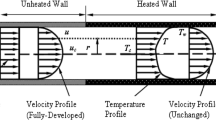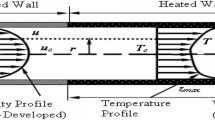Abstract
Fully developed turbulent pipe flow at low Re-number is studied by means of direct numerical simulation (DNS). In contrast to many previous DNS's of turbulent flows in rectangular geometries, the present DNS code, developed for a cylindrical geometry, is based on the finite volume technique rather than being based on a spectral method. The statistical results are compared with experimental data obtained with two different experimental techniques. The agreement between numerical and experimental results is found to be good which indicates that the present DNS code is suited for this kind of numerical simulations.
Similar content being viewed by others
References
Eggels, J.G.M., Pourquié, M.J.B.M., Nieuwstadt, F.T.M.: 1992, Large-eddy simulation of turbulent pipe flow. Submitted toTheoretical and Computational Fluid Dynamics.
Eggels, J.G.M., Unger, F., Weiss, M.H., Westerweel, J., Adrian, R.J., Friedrich, R., Nieuwstadt, F.T.M.: 1992, Fully developed turbulent pipe flow: A comparison between direct numerical simulation and experiment. In preparation.
Eggels, J.G.M., Westerweel, J., Nieuwstadt, F.T.M., Adrian, R.J.: 1993, A comparison of flow structures in DNS & PIV studies of turbulent pipe flow. To be presented atInt. Conf. on Near-wall Turbulent Flows, March 15–18, 1993, Tempe, AZ, USA.
Grötzbach, G.: 1983, Spatial resolution requirements for direct numerical simulation of the Rayleigh-Bénard convection.J. Comp. Phys. 49, 241–264
Kim, J., Moin, P., Moser, R.: 1987, Turbulence statistics in fully developed channel flow at low Reynolds number,J. Fluid Mech. 177, 133–166.
Patel, V.C., Head, M.R.: 1969, Some observations on skin friction and velocity profiles in fully developed pipe and channel flows,J. Fluid Mech. 38, 181–201.
Unger, F., Friedrich, R.: 1991, Large eddy simulation of fully-developed turbulent pipe flow. Proceedings of the8th Symp. on Turbulent Shear Flows, Sept. 9–11, München, Germany, pp. 19-3-1 – 19-3-6.
Westerweel, J., Adrian, R.J., Eggels, J.G.M., Nieuwstadt, F.T.M.: 1992, Measurements with particle image velocimetry on fully developed turbulent pipe flow at low Reynolds number. Proceedings of the6th Int. Symp. on Applications of Laser Techniques to Fluid Mechanics, July 20–23, Lisbon, Portugal.
Author information
Authors and Affiliations
Rights and permissions
About this article
Cite this article
Eggels, J.G.M., Westerweel, J., Nieuwstadt, F.T.M. et al. Direct numerical simulation of turbulent pipe flow. Appl. Sci. Res. 51, 319–324 (1993). https://doi.org/10.1007/BF01082555
Issue Date:
DOI: https://doi.org/10.1007/BF01082555




